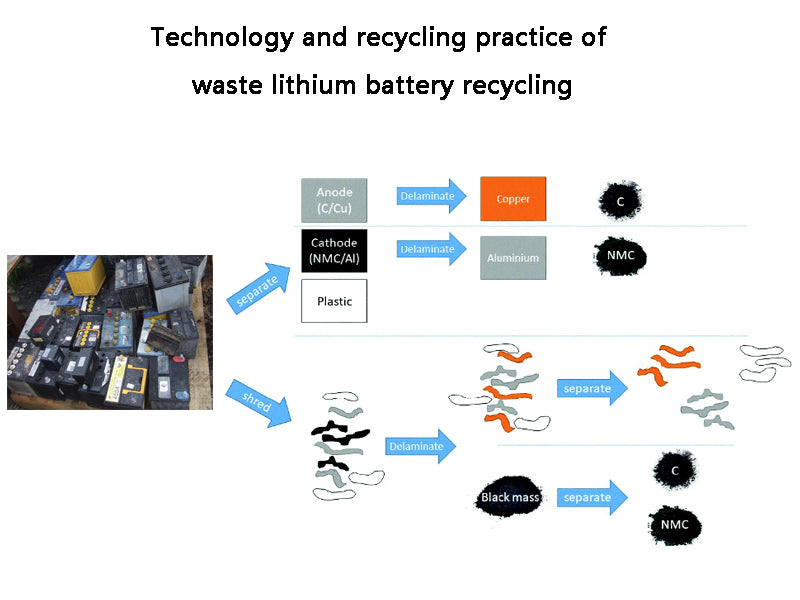
main content:
1. The technology of recycling waste lithium battery

The cost of developing waste battery resources can be attributed to the following.
①The cost of collecting waste batteries from consumers to waste battery disposal sites.
② The production expenditures required for the disposal of waste batteries after they are collected at the disposal site, including the required production materials, labor, water and electricity, and expenses necessary to maintain the normal operation of the enterprise. This part of the expenditure is largely determined by the quality of the waste battery recycling process and the level of recycling.
③Sales cost and financial management cost of products recovered from waste batteries. Generally speaking, the higher the level of recycling technology, the greater the use value and profit created by the recovered products, and the lower the cost of sales.
④ Environmental protection costs in the process of recycling waste batteries. According to the requirements of harmless disposal, this part of the expenditure is usually relatively high.
The main benefits of recycling waste batteries are as follows.
①Material sales revenue from the recycling process All kinds of metal materials in waste batteries are the main products for recycling, and their value is determined to a large extent by the recovery rate of various metals and the degree of separation from each other. The recycling process and level determine the above two factors.
②Environmental benefits brought by the harmless recycling of waste batteries This part of the income is often the economic return that cannot be directly obtained by recycling enterprises, but it is huge for the whole society and the battery industry.
According to reports, one of the current feasible treatment processes for lithium batteries is to discharge the battery through a salt solution and make the battery harmless, and then carry out a double liner safe landfill, the cost is 1.46~12.7 US dollars / kg; but there is no mention here. And the recycling of useful resources in lithium batteries, the income after recycling of metals in waste batteries is not calculated.
According to reports, when using the full wet process of alkali leaching→acid solution→purification→cobalt precipitation to recover aluminum and cobalt from the anode waste of lithium ion secondary battery—aluminum-cobalt film, according to the current market conditions and the actual industrial production According to the raw material consumption of processing 1t of aluminum diamond film waste and the cost and benefit estimate of the process, it can be calculated that each 1t of aluminum-cobalt film waste can obtain a net profit of 45,600 yuan. .
However, this calculation is only a rough estimate of the laboratory situation, and various factors should be comprehensively considered when applied to actual production, such as national economic policies, price fluctuations, degree of recovery and purity.
2. Recycling and Utilization Practices of Waste Lithium Batteries in Various Countries
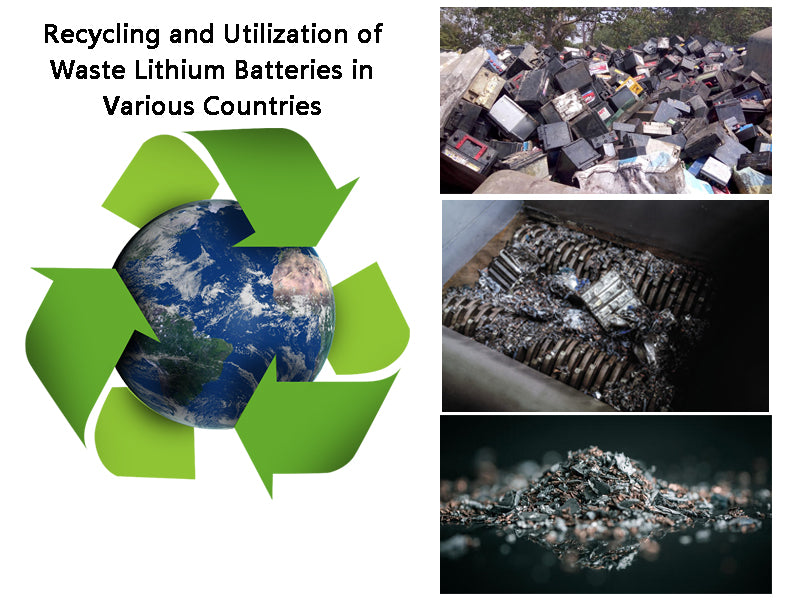
At present, some companies in various countries have recycled and utilized lithium-ion batteries and the introduction is as follows.
1) Switzerland
Switzerland has a good waste battery recycling system, mainly recycling and processing waste ordinary batteries and rechargeable batteries. The charging for the recycling of waste batteries is related to the type of waste batteries themselves: the recycling of rechargeable batteries such as lithium-ion batteries is paid by the enterprise to the processor; while the recycling of ordinary batteries is paid by the consumer.
Batrec is one of two factories in Switzerland engaged in the recycling and utilization of waste batteries. It can recycle and process rechargeable batteries such as lithium-ion batteries, ordinary batteries, and mercury-containing wastes such as light bulbs, lamps and switches. The annual processing capacity of various types of waste batteries is 3300t, including 2500t in Switzerland and 800t abroad.
The enterprise has passed ISO 9001 and ISO 14000 environmental quality system certification. The recycling process of waste batteries includes transportation, sorting, treatment and recycling. The quality of recycled metals and other products is good, for example, the zinc content of zinc plates can reach 98.8%. The company's recycling process includes: lithium-ion battery recycling process, hybrid battery recycling and utilization process, and mercury-containing waste treatment recycling process. The following is a brief introduction to the lithium-ion battery recycling and utilization process and the hybrid battery recycling process.
(1) Lithium-ion battery recycling
After the recovered batteries are screened and manually sorted, the lithium batteries are classified centrally, and other batteries are sent to partners such as Accureca for processing. The treatment process of lithium battery: high pressure and normal temperature crushing → neutralization of lithium → metal separation, after repeated separation, non-ferrous metals such as nickel-chromium alloy and cobalt, as well as manganese oxide and plastic, are finally sorted. The recycling of lithium-ion batteries has great economic and environmental benefits, and is the company's key business. The process is shown in Figure 1. The products obtained by recycling primary lithium batteries are shown in Figure 2; the products obtained by recycling secondary lithium batteries are shown in Figure 3.
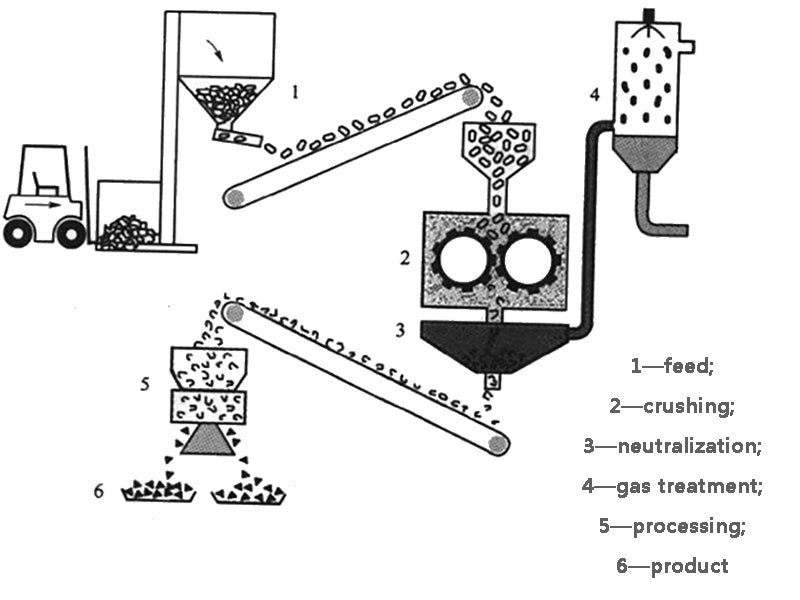
Figure 1 Processing flow of lithium battery
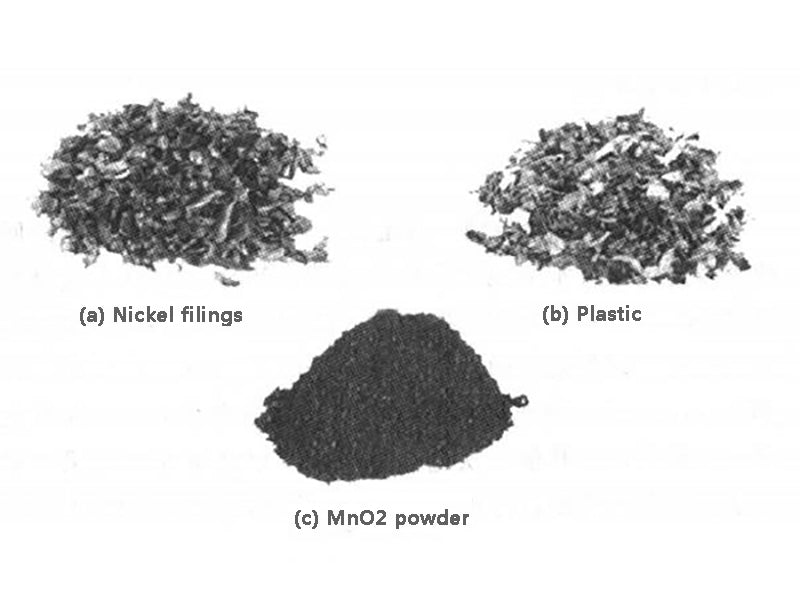
Figure 2 Product obtained from recycling and processing primary lithium batteries
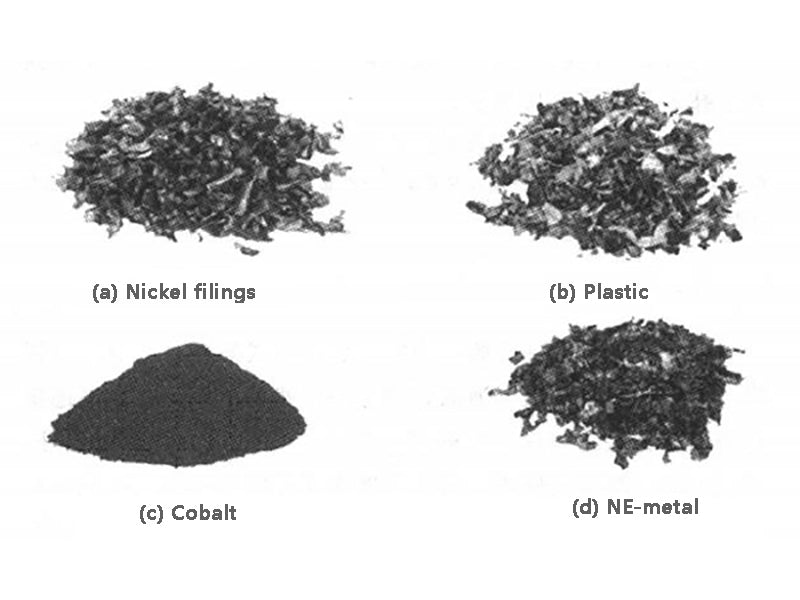
Figure 3 Products obtained by recycling and processing secondary lithium batteries
(2) Hybrid battery recycling
The company has two mixed battery recycling and processing production lines, the products are nickel-chromium alloy, cobalt, zinc, manganese ferroalloy, mercury and so on. The first production line was introduced from Japan with a production capacity of 2000t/a; the second production line was built on the basis of the imported technology with a production capacity of 3000t/a. At present, the company's waste battery processing capacity is 5000t/a, and the products obtained are: 780t manganese ferroalloy, 400t zinc alloy and 3t mercury.
According to the company's experience, secondary rechargeable batteries are harmful to the environment but have good recycling value, especially the economic value of lithium-ion battery recycling is the highest. The recycling and processing production line of ordinary dry batteries can also be used to process other mercury-containing wastes after appropriate improvement.
2) Japan
Japan has been at the forefront of the world in recycling and disposing of waste batteries, and its secondary battery recycling rate is relatively high. According to the Japan Battery Industry Association, 2000 was the first year of the Japanese government's implementation of the "3R" plan, which changed the past "mass production, mass consumption, mass waste" to the current "recycle, reduce". , reuse”. At present, all lead-acid batteries used in automobiles have been recycled, and there are mature treatment methods. The recovery rate of other secondary batteries has also reached 84%. The method used is to place recycling boxes in major shopping malls and public places, and rely on the sponsorship of battery manufacturers to carry out recycling. Waste secondary batteries are generally disintegrated and burned, and then separated to recover useful metals or their compounds. The process flow of Japan's waste lithium-ion battery regeneration technology is as follows.
Battery pack → disintegration → recycling of plastic and metal shells, single cell roasting → crushing → sorting → magnetic separation of iron from the sieve, and under sieve → acid dissolution → filtration → adding bromic acid reaction → filtration → cobalt bromate → drying →Heat treatment →Cobalt compound
3) Germany
Since October 1998, Germany has legalized the recycling of batteries. However, it is understood that the treatment method of primary batteries is still deeply buried. For example, a "wet treatment" device is being built in the suburbs of Magdeburg. Here, except for lead-acid batteries, all kinds of batteries are dissolved in sulfuric acid, and then various metals are extracted from the solution with the help of ionic resin. The product obtained in this way is purer than the product obtained by the heat treatment method, so it is more expensive in the market, and about 95% of the various substances contained in the battery can be extracted. The annual processing capacity of this plant in Magdeburg can reach 7500t. Although the cost is slightly higher than the landfill method, the valuable raw materials will not be discarded and will not pollute the environment.